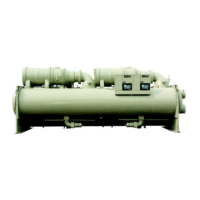Product Manual PM WSC/WDC 9
The REAL FACTS On Speed-Rpm and Tip Speed In Centrifugal Compressors
The question: "How fast does it spin?" is a common curiosity when discussing compressors. There is a
widespread idea promoted by manufacturers of direct-drive compressors that rpm is the determining factor in
the life, reliability and efficiency of the compressor. This is absolutely false. An engineering examination will
show that rpm, as an absolute, is not considered in the design of rotating mechanical components. It is the
combination of velocity of the outside edge of the impeller (tip speed), mass, and physical size that define the
design criteria for these components. Shaft, bearing, and impeller design is based on parameters such as
surface velocity, diameter, weight, rotational and torsional critical speed, as well as the type of material and
lubrication system used.
Stress on an impeller is proportional to the square of the tip speed. Rotational speed is only part of the
equation along with impeller diameter.
In designing a centrifugal compressor, two fundamental parameters, impeller diameter and impeller tip speed,
must be determined. Impeller diameter is determined by the required volume flow rate supplied to the inlet of the
impeller. Refrigerants which operate at a negative pressure such as HCFC-123 have high cfm/ton (m
3
/kW) flow
rates and require larger diameter impellers and refrigerant lines to keep pressure drop to reasonable levels.
Pressure drop reduces refrigeration capacity and increases input power. Systems with refrigerants, which
operate at a positive pressure such as HFC-134a, have smaller impellers and gas lines since these refrigerants
require lower gas flow rates. HCFC-123 requires approximately six times the gas flow rate in cfm per ton than
HFC-134a. At ARI standard conditions, 18.1 cfm (8.54 l/sec) of HCFC-123 is required per ton of refrigeration.
Contrast this to HFC-134a which requires 3.2 cfm (1.5 l/sec) per ton. This means that for a given capacity, the
cross-sectional area of the impeller inlet "wheel eye" as well as the suction and discharge lines will be six times
larger for HCFC-123 than for HFC-134a at equivalent pressure drops. The wheel eye diameter is the major factor
in determining the overall impeller diameter and geometry.
In addition to wheel eye diameter, designers of centrifugal equipment must consider the tip speed requirement.
To produce the required pressure difference or "lift", a centrifugal impeller must achieve a given "tip speed." Tip
speed is the velocity of the "tip" of the impeller relative to its surroundings. Imagine an observer standing on
the impeller. The observer sees his surroundings pass by him at a certain velocity. This velocity is the impeller
tip speed, usually expressed in feet per second (meters per second). An analogy may be drawn to a car driving
down a road. The tip speed of the tire is equal to the speed of the car.
Since all the refrigerants that have been discussed require tip speeds in the range of 670 to 700 ft/sec (204 to 213
m/sec), we see that the impeller angular velocity (rpm) is largely affected by its diameter. It was pointed out
earlier that negative pressure impellers must be larger than those in positive pressure machines due to the
drastic differences in required gas flow rates. Larger diameter impellers must rotate at slower rpm than smaller
diameter impellers. Referring again to the car example demonstrates that different combinations of diameter and
rpm produce the same tip speed. Imagine a freeway carrying vehicles with different size tires all traveling at 55
mph. The tip speed of all of the tires is fixed at 55 mph even though the small tires of a utility trailer rotate at a
much higher rpm than the large tires of a tractor-trailer.
The relationship of diameter and tip speed can be shown by the following equation:
rpm TipSpeed fps x Diameter in= ( ) . / ( .)2292
rpm TipSpeed m s x Diameter cm= ( / ) / ( .)1910
Again, this indicates that for a given speed requirement, a smaller diameter impeller in a compressor will operate
at a higher rpm than a larger diameter impeller. Again:
Stress ∝∝ Tip Speed
2
Impellers with similar tip speeds have similar stress.

